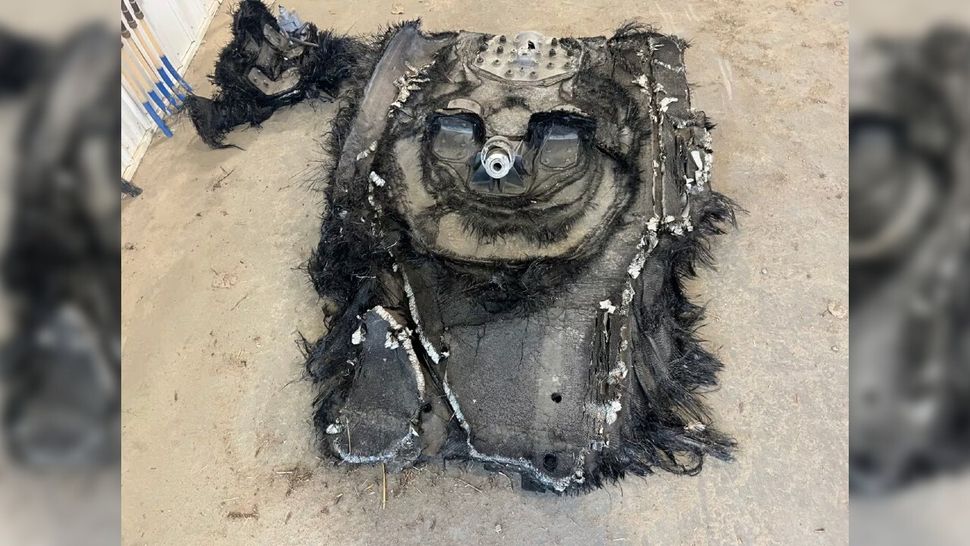
A new, deadly era of space junk is dawning, and no one is ready (Image Credit: Space.com)
Originally published at Scientific American.
Samantha Lawler is an assistant professor of Astronomy at the University of Regina.
The e-mail arrived, like a bolt from blue, on the otherwise typical Thursday afternoon of May 9. The message was from a journalist, asking me, an astronomer, for an interview about a farmer who had reportedly found space junk while prepping his fields for springtime seeding, just an hour’s drive from my home in Saskatchewan. “Yeah, right,” I said to myself as I tapped out my affirmative reply. The odds are already long for any particular place on Earth to be struck by orbital debris—so the chances for it to happen practically in the backyard of someone like me who studies the issue felt astronomically low, simply too far-fetched to be true.
A quick check of my news feed proved me wrong. One of the top stories was about the space junk strike, and even included a photo of the farmer, Barry Sawchuk, standing next to what looked like the charred, battered hood of a semitruck covered with woven carbon fiber and a few slightly melted aluminum protrusions. My jaw dropped in shock: The object looked exactly like debris that fell in an Australian sheep field in 2022, which the U.S. aerospace company SpaceX later admitted was part of a cargo trunk for its Crew Dragon spacecraft. This “trunk” is actually the size of a small grain silo, and is ejected in orbit well before the spacecraft’s atmospheric reentry, to naturally and chaotically reenter on its own and, supposedly, burn up completely.
To confirm my hunch, I immediately e-mailed my collaborator Jonathan McDowell, an astronomer at the Center for Astrophysics | Harvard & Smithsonian, who maintains probably the best public database of launches, reentries and other space activities. McDowell responded within minutes, forwarding a graphic tracing the path of a SpaceX Crew Dragon trunk ejected by the Axiom 3 private astronaut mission that had reentered over the Canadian prairies on February 26, 2024. My hunch was confirmed.
As an astronomer, I already had good reasons to worry about SpaceX. The company has been launching huge numbers of its Starlink internet broadband satellites since 2019; more than 6,000 are in orbit, and as many as 42,000 are planned. As Starlink grew—along with competing plans for other satellite “mega constellations”—my telescope data and my huge prairie sky filled with bright, easily visible satellites just as many astronomers (including myself) had warned. Beyond this disruptive light pollution, though, new research shows that atmospheric pollution is skyrocketing from the SpaceX-dominated dramatic increase in launches and reentries—with potentially disastrous global effects. The aluminum oxide produced by sublimating satellites in Earth’s upper atmosphere, it turns out, is a potent and lasting catalyst for chemical reactions similar to those that in the 20th century famously corroded a gaping hole in our planet’s delicate, radiation-blocking ozone layer.
Those of us who are fortunate enough to be able to escape urban light pollution default to being bystanders to this sullying of the sky; we look up, feel overwhelmed, and look away. This latest situation, with the company’s activity showering my neighbors with dangerous debris, somehow felt more personal. So I decided to act, and to help hold SpaceX accountable.

I got Sawchuk’s phone number from the journalist who had contacted me, and the farmer took my call from the cab of his tractor as he was busily seeding. He was extremely annoyed that SpaceX was allowed to dump its orbital trash onto his farm, he said, and had assumed the best response was to tell his story in the news media. But the initial response was subdued; most journalists didn’t prioritize following up on a rural Saskatchewan farmer saying he found a piece of space junk. Sawchuk gave me permission to pass along his phone number to curious minds, with one proviso: “I won’t respond to texts while I’m driving the tractor!” I began brainstorming a list of every space law and orbital debris expert I could think of to ask for advice.





